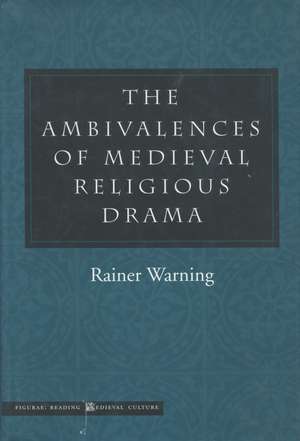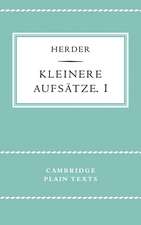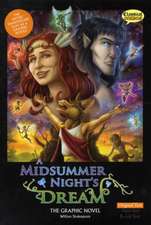The Ambivalences of Medieval Religious Drama: Figurae: Reading Medieval Culture
Autor Rainer Warning Traducere de Steven Rendallen Limba Engleză Hardback – 28 feb 2002
What is medieval religious drama, and what function does it serve in negotiating between the domains of theology and popular life? This book aims to answer these questions by studying three sets of these dramas: tenth-century Easter plays, twelfth-century Adam plays, and fifteenth- and sixteenth-century Passion plays.
However, the author’s intent is not to present a genre history. Instead, he seeks to mediate between the historical development of the plays and a systematic unfolding of the archetypal structure within which the plays grasp salvation history and act it out. His theoretical approach is grounded in the work of Niklas Luhmann, which strongly emphasizes the priority of social functions over institutional structures.
The book’s textual basis is truly European—including works from Germany, France, England, and Spain—and goes beyond “literary” texts to engage a range of sources from sparsely documented folk rituals to high medieval theology. These sources enable the author to encompass the complex structure of popular feasts and religious celebrations that centered on Easter. His methodological program—a systematically informed, structured analysis sensitive to the historical context—identifies recurrent patterns of distortion in these feasts and celebrations vis-à-vis their model, the chapters of Scripture dealing with Christ’s death and resurrection.
Eschewing the conventional view of medieval theater as a depiction of medieval theology, the author convincingly shows that below their textual surfaces, the Easter theatrical and religious celebrations must have served as collective rituals of compensation in whose context the figure of Christ (often, specifically, the actor incarnating the figure) took over the role of the scapegoat. This demonstrates another of the book’s major contributions, that a collaboration between medieval studies and contemporary cultural theory is not only viable but richly rewarding.
However, the author’s intent is not to present a genre history. Instead, he seeks to mediate between the historical development of the plays and a systematic unfolding of the archetypal structure within which the plays grasp salvation history and act it out. His theoretical approach is grounded in the work of Niklas Luhmann, which strongly emphasizes the priority of social functions over institutional structures.
The book’s textual basis is truly European—including works from Germany, France, England, and Spain—and goes beyond “literary” texts to engage a range of sources from sparsely documented folk rituals to high medieval theology. These sources enable the author to encompass the complex structure of popular feasts and religious celebrations that centered on Easter. His methodological program—a systematically informed, structured analysis sensitive to the historical context—identifies recurrent patterns of distortion in these feasts and celebrations vis-à-vis their model, the chapters of Scripture dealing with Christ’s death and resurrection.
Eschewing the conventional view of medieval theater as a depiction of medieval theology, the author convincingly shows that below their textual surfaces, the Easter theatrical and religious celebrations must have served as collective rituals of compensation in whose context the figure of Christ (often, specifically, the actor incarnating the figure) took over the role of the scapegoat. This demonstrates another of the book’s major contributions, that a collaboration between medieval studies and contemporary cultural theory is not only viable but richly rewarding.
Din seria Figurae: Reading Medieval Culture
-
 Preț: 194.70 lei
Preț: 194.70 lei -
 Preț: 331.63 lei
Preț: 331.63 lei -
 Preț: 273.03 lei
Preț: 273.03 lei -
 Preț: 274.79 lei
Preț: 274.79 lei -
 Preț: 196.89 lei
Preț: 196.89 lei -
 Preț: 272.16 lei
Preț: 272.16 lei -
 Preț: 288.30 lei
Preț: 288.30 lei -
 Preț: 512.49 lei
Preț: 512.49 lei - 19%
 Preț: 451.31 lei
Preț: 451.31 lei - 19%
 Preț: 451.93 lei
Preț: 451.93 lei -
 Preț: 483.04 lei
Preț: 483.04 lei - 19%
 Preț: 445.39 lei
Preț: 445.39 lei - 19%
 Preț: 479.21 lei
Preț: 479.21 lei - 19%
 Preț: 508.71 lei
Preț: 508.71 lei -
 Preț: 519.02 lei
Preț: 519.02 lei - 19%
 Preț: 510.12 lei
Preț: 510.12 lei - 19%
 Preț: 537.57 lei
Preț: 537.57 lei - 19%
 Preț: 535.36 lei
Preț: 535.36 lei - 19%
 Preț: 511.35 lei
Preț: 511.35 lei - 19%
 Preț: 508.88 lei
Preț: 508.88 lei
Preț: 535.54 lei
Preț vechi: 661.16 lei
-19% Nou
Puncte Express: 803
Preț estimativ în valută:
102.49€ • 106.60$ • 84.61£
102.49€ • 106.60$ • 84.61£
Carte tipărită la comandă
Livrare economică 14-28 aprilie
Preluare comenzi: 021 569.72.76
Specificații
ISBN-13: 9780804737913
ISBN-10: 0804737916
Pagini: 336
Dimensiuni: 152 x 229 x 25 mm
Greutate: 0.59 kg
Ediția:1
Editura: Stanford University Press
Colecția Stanford University Press
Seria Figurae: Reading Medieval Culture
ISBN-10: 0804737916
Pagini: 336
Dimensiuni: 152 x 229 x 25 mm
Greutate: 0.59 kg
Ediția:1
Editura: Stanford University Press
Colecția Stanford University Press
Seria Figurae: Reading Medieval Culture
Recenzii
"Medievalists in general as well as scholars of drama in particular will find this an important and thought-provoking study that is as relevant now as it was thirty years ago."—Claire Sponsler, University of Iowa
"...A remarkable undertaking."—Comparative Drama
Notă biografică
Rainer Warning is Professor at the Institut für Romanische Philologie of the University of Munich. This is his first book to be translated into English.
Textul de pe ultima copertă
“Medievalists in general as well as scholars of drama in particular will find this an important and thought-provoking study that is as relevant now as it was thirty years ago.”—Claire Sponsler, University of Iowa
“...A remarkable undertaking.”—Comparative Drama
“...A remarkable undertaking.”—Comparative Drama
Descriere
What is medieval religious drama, and what function does it serve in negotiating between the domains of theology and popular life? This book aims to answer these questions by studying three sets of these dramas from Germany, France, England, and Spain: 10th-century Easter plays, 12th-century Adam plays, and 15th- and 16th-century Passion plays.












